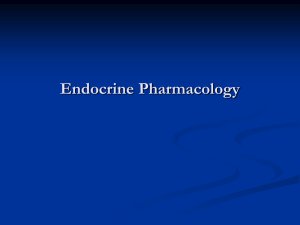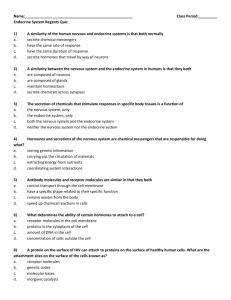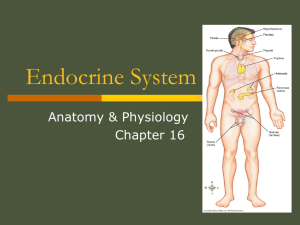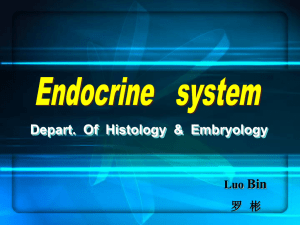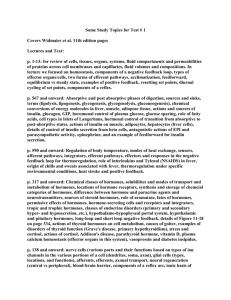Laboratory Exercise 17: Anatomy of the Endocrine System
advertisement
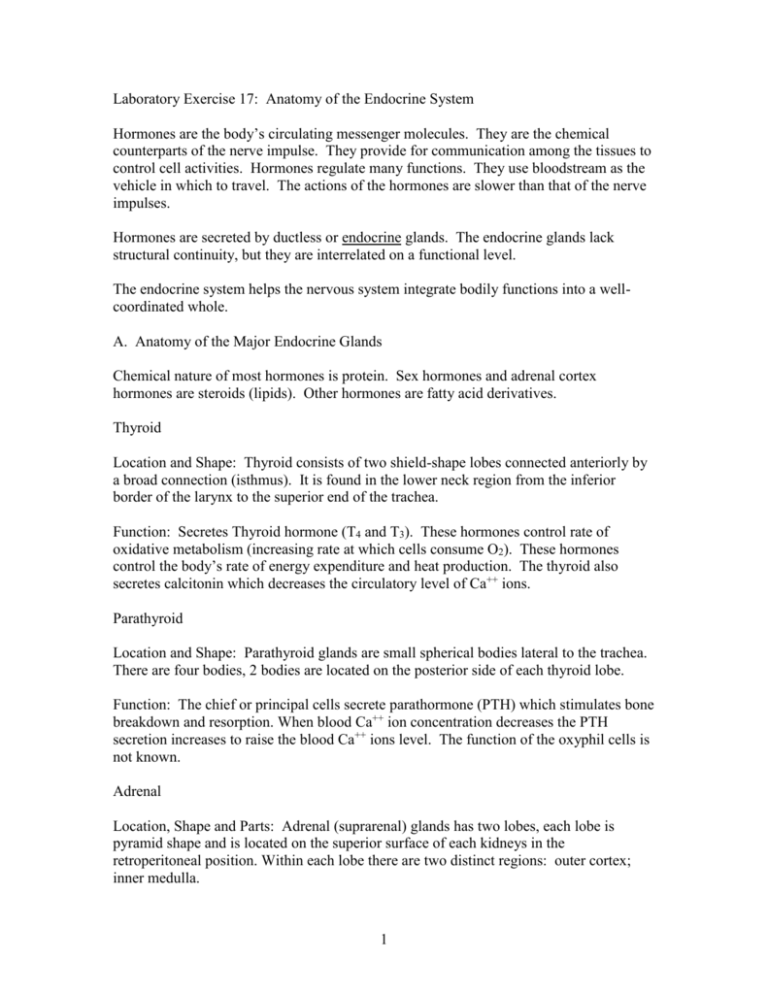
Laboratory Exercise 17: Anatomy of the Endocrine System Hormones are the body’s circulating messenger molecules. They are the chemical counterparts of the nerve impulse. They provide for communication among the tissues to control cell activities. Hormones regulate many functions. They use bloodstream as the vehicle in which to travel. The actions of the hormones are slower than that of the nerve impulses. Hormones are secreted by ductless or endocrine glands. The endocrine glands lack structural continuity, but they are interrelated on a functional level. The endocrine system helps the nervous system integrate bodily functions into a wellcoordinated whole. A. Anatomy of the Major Endocrine Glands Chemical nature of most hormones is protein. Sex hormones and adrenal cortex hormones are steroids (lipids). Other hormones are fatty acid derivatives. Thyroid Location and Shape: Thyroid consists of two shield-shape lobes connected anteriorly by a broad connection (isthmus). It is found in the lower neck region from the inferior border of the larynx to the superior end of the trachea. Function: Secretes Thyroid hormone (T4 and T3). These hormones control rate of oxidative metabolism (increasing rate at which cells consume O2). These hormones control the body’s rate of energy expenditure and heat production. The thyroid also secretes calcitonin which decreases the circulatory level of Ca++ ions. Parathyroid Location and Shape: Parathyroid glands are small spherical bodies lateral to the trachea. There are four bodies, 2 bodies are located on the posterior side of each thyroid lobe. Function: The chief or principal cells secrete parathormone (PTH) which stimulates bone breakdown and resorption. When blood Ca++ ion concentration decreases the PTH secretion increases to raise the blood Ca++ ions level. The function of the oxyphil cells is not known. Adrenal Location, Shape and Parts: Adrenal (suprarenal) glands has two lobes, each lobe is pyramid shape and is located on the superior surface of each kidneys in the retroperitoneal position. Within each lobe there are two distinct regions: outer cortex; inner medulla. 1 Function: Medulla secretes epinephrine and norepinephrine under the control of the sympathetic nervous system. The function of these hormones is to increase rate and strength of the heart contractions, vasoconstriction and bronchodilation. Epinephrine increases the conversion of glycogen to glucose. ACH secreted by the parasympathetic nervous system has the opposite effects. ACH slows the rate and strength of heart contractions. Cortex is differentiated into 3 layers of secretory cells which secrete a specific type of steroid hormone. Zona Glomerulosa: secretes mineralocorticoids, which adjust the concentration of Na+ and K+ ions in the body fluids. Zona Fasciculata: secretes glucocorticoids which controls carbohydrate metabolism. Zona Reticularis: secretes sex hormones (androgens and estrogens). Pancreas Location, Shape and Parts: Pancreas is a flat tail-like organ, located dorsal to the greater curvature of the stomach retroperitoneal. It is classified as both an endocrine and an exocrine gland. The exocrine part predominates in the form of circular groups of cells, the acini, which produce digestive enzymes. The endocrine part is in the clusters of cells, the islets of Langerhans which are interspersed between acini. The islets contain alpha (α) and beta (ß) cells. Function: Alpha cells produce and secrete glucagon, which raises blood glucose by promoting glycogenolysis in the liver. Beta cells produce and secrete insulin, which increases cellular uptake of glucose and promotes glycogenesis. Insulin and glucagon work antagonistically to each other to control blood glucose concentration. Pituitary (Hypophysis) Location, Shape and Parts: Pituitary is a combination of glandular and neuroendocrine tissues. It’s the size and shape is that of a pea and is suspended from the hypothalamus by the infundibulum stalk. It lies within the sella turcica of the sphenoid bone of the cranium. 2 Anterior lobe, adenohypophysis glandular Posterior lobe, neurohypophysis nervous Pars distalis Pars intermedia Pars nervosa infundibulum Function: Adendohypophyseal hormones secretion is controlled by specific releasing factors from the hypothalamus which reach the adendohypophysis by a network of blood vessels (the hypothalamic-hypophyseal portal system). Anterior lobe hormones control other endocrine glands, thereby exerting an indirect effect on growth and metabolism. When another endocrine gland is the target organ, the pituitary hormone is termed a tropin or tropic hormone. Thyrotropin (TSH) – stimulates thyroid gland cells to secrete thyroxin. Adrenocorticotropin (ACTH) – stimulates adrenal cortex to secrete steroid hormones. In females – Follicle-Stimulating Hormone (FSH) – promotes maturation of ova and stimulates follicular cells to produce estrogens. Luteinizing Hormone (LH) – triggers ovulation, converts the ovulated follicle into a corpus luteum and stimulates corpus luteal cells to secrete progesterone. In males FSH promotes maturation of sperms. LH or Interstitial Cell-Stimulating Hormone (ICSH) – stimulates the interstitial cells of the seminiferous tubules to secrete androgens (testosterone). Prolactin (PRL) – acts on mammary gland cells to promote milk production. The secretion of prolactin and milk production is inhibited until childbirth. Growth Hormone (GH) – has a general anabolic effect on body organs, especially muscles and long bones. GH is essential for retention of body protein. Neurohypophysis The axons in the posterior lobe are from neurons cell bodies in the hypothalamus. The cell bodies make the hormones and the nerve fibers (axons) store the hormones in their terminal branches. Nerve impulses from the hypothalamus cause the release of these hormones. Function: Antidiuretic Hormone (ADH) – promotes water conservation by the kidneys. ADH secretion is controlled by osmoreceptor neurons in the hypothalamus. These cells 3 monitor the osmotic pressure (solute concentration) of the blood. As solute concentration of the blood increases, this causes an increased release of ADH from the neurohypophysis. The ADH increases water reabsorption by the kidneys. This dilutes the blood and maintains proper salt to water balance. Oxytocin elicits strong uterine muscle contractions during labor (parturition of the fetus) and causes milk ejection during breast feeding. Gonads Testes Location and Shape: Testes located in the scrotum, as they descend, they carry abdominoplevic cavity with them. The testes are oval in shape. Function: The interstitial cells of the testes produce the male sex hormones, androgens, the principal hormone, is testosterone. Androgens functions to control: development of male secondary sex characteristics and sex drive; sex organ and accessory sex gland growth and development. Ovaries Location and Shape: Ovaries located in upper pelvic cavity. The ovaries are almond shaped. Functions: Estrogens functions: maturation of female sex organs; cyclical changes in the uterine lining; development of the breasts and other female secondary sex characteristics; stimulation of uterine smooth muscle. Functions: Progesterone functions: after the corpus luteum is formed it produces progesterone. The progesterone which functions to: set the stage for pregnancy by the thickening of the uterine lining; increases breast development during gestation; acts to prevent spontaneous abortion (miscarriage). Thymus Location and Shape: Thymus is a two-lobed structure lying in the upper chest cavity (mediastinum of the thoracic cavity) superior to the heart and inferior to the sternum. It is large during childhood, but atrophies after puberty. 4 Function: Thymus plays a role in the development of immune responses to agents foreign to the body. Early in life, stem cells from the bone marrow circulate to the gland and develop into T-lymphocytes. The T-cells then colonize the spleen and lymph nodes, where they provide cellular immunity when exposed to antigens. The hormone, thymocin, stimulates the activity of T-cells after they have migrated to other lymphoid tissues. B. Histology of the Endocrine Glands Thyroid Spherical sacs, thyroid follicles, contain a colloidal suspension of thyroglobulin, the storage form of the thyroid hormone, thyroxin. The follicle cells are simple cuboidal epithelium. Cells lying between the follicle cells are the parafollicular cells (C cells). The C cells produce the hormone, Calcitonin (CT). Calcitonin functions to lower blood Ca++ ion concentration. It does so by inhibiting bone resorption by the osteoclasts and thus by increasing Ca++ ion uptake into bone marrow. Calcitonin and PTH are antagonistic acting hormones. Adrenal This gland is differentiated into an outer cortex and an inner medulla. Medulla – organized into irregular clusters of epithelial cells surrounded by large blood vessels. The cells are embedded in a reticular connective tissue network. The adrenal medulla cells secrete epinephrine (E) and norepinephrine (NE). Cortex – divided into 3 regions according to type and arrangement of the cells. Zona Glomerulosa (ZG) – in the outer most layer, the cells arranged in oval-shaped groups. Secrete mineralocorticoids which control electrolyte and water homeostasis. Zona Fasciculata (ZF) – in the intermediate cortical layer, the cells are arranged into cords two cells wide. Secrete glucocorticoids which control carbohydrate metabolism. Zona Reticularis (ZR) – in the inner most layer, next to the medulla, the cells are arranged into interconnecting irregular cords. Secrete small amounts of sex hormones. 5 Pancreas The endocrine tissue of the pancreas consists of islets in between the exocrine acini. The cytoplasm of the islet cells stain less intensely than acinar cells, so islets stand out against the darker exocrine acinar cells. Alpha cells secrete glucagon. Beta cells secrete insulin. Pituitary Adenohypophysis – glandular tissue stains darker. These cells secrete the tropic hormones. Neurohypophysis – nervous tissue stains lighter. The neurohypophysis contains nerve fibers from the hypothalamus and neuroglial cells. Secrete ADH and oxytocin (OT). 6



